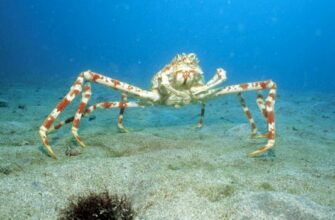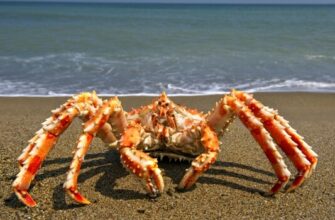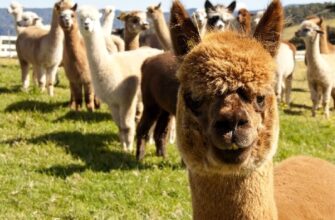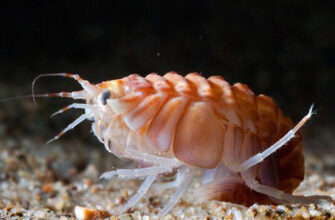The most popular harmless vagrant of the sea, preferring shallow water, is the hermit crab. For self-defense and as a home, he uses a shell, which he constantly wears on his back. It is also one of the natural cleaners of the environment, since it feeds mainly on organic debris.
Origin of the species and description
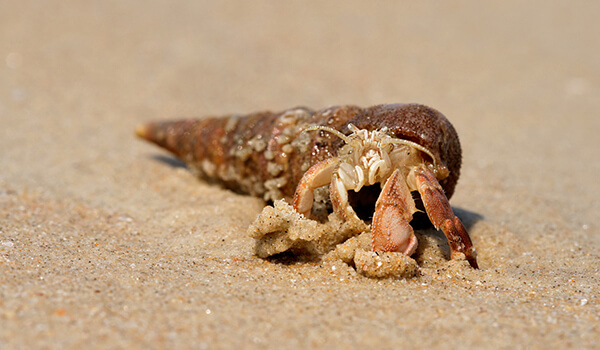
Photo: Hermit Crab
The hermit crab is a species of ten-legged marine crayfish, part-tailed infoorder, which inhabit the shallow waters of the coastal zones of the subtropics and tropics. He is unpretentious in food, omnivorous. His main feature is that he always wears a shell on himself. The shell, which serves as a home for the hermit crab, often comes from molluscs.
The entire back of the crab's body easily fits in the shell, and the front remains outside. A kind of shell house serves as an excellent protection for the arthropod, so it never leaves it, but changes it as necessary when its size increases.
Video: Hermit crab
Today there are a large number of different types of hermit crabs that inhabit all the seas of the planet. The largest species reaches 15 cm in size. The hermit crab is difficult to see, only in rare cases when it leaves its shelter. The body of an arthropod transforms over time to fit the characteristics of the shell in which it lives.
For additional protection, cancer has at its disposal a variety of devices, incl. a layer of chitin, abundantly covering the front of the body. The shell serves to protect the animal from enemies. Hermit crab removes it during the molting period. Over time, a new layer of chitin grows back on his body. Old carapace can serve as food for cancer.
Appearance and features
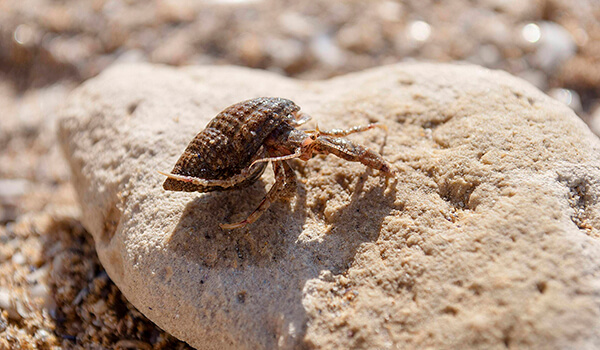
Photo: What a hermit crab looks like
Dimensions Hermit crabs are diverse and depend on its type. From the smallest 2 cm to the largest 15 cm. The appearance of the hermit crab is very unusual.
The body is divided into the following parts:
- soft torso;
- head to chest;
- legs;
- moustache;
- pincers.
The pincers are located next to the head. The right claw is larger than the left. Cancer uses it as a gate to the entrance to the dwelling. The left claw is used by the hermit to get food. The legs, which are used by the arthropod for movement, are located next to the claws. Other small limbs are not used for cancer.
The front part of the body is covered with chitin, which forms a fixed shell. Chitin does not cover the back soft part of the torso of the hermit crab, so he hides it in the shell. Small hind limbs securely fix the shell, so the arthropod never loses it.
Hermit crabs use the shells of various mollusks as their houses:
- rapans;
- gibull;
- nassa;
- ceritium.
For convenience, an arthropod chooses a shell of a size that exceeds its body. The large claw of the hermit crab securely blocks the entrance to the shelter. Hermit crabs actively increase in size throughout their lives, so they are forced to constantly expand their living space. To do this, as necessary, they change their shell to large sizes, using only free ones. If a hermit crab for some reason does not find a suitable shell, it can settle down with another relative.
Interesting fact: As a house, a hermit crab can use not only a clam shell, but others objects of suitable shape: glass, lid, etc.
Where does the hermit crab live?
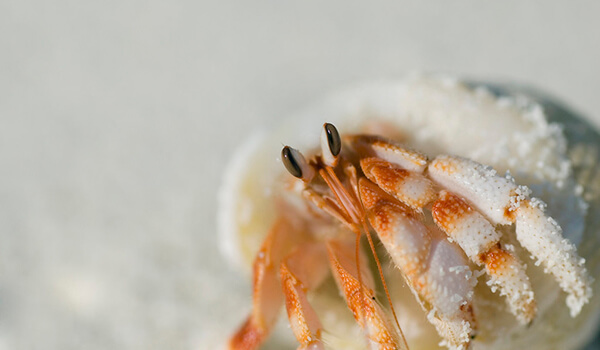
Photo: Black Sea hermit crab
Hermit crabs inhabit exclusively reservoirs with clean water. Therefore, a large settlement of these arthropods indicates a clean ecological situation in this place. Recently, the catastrophic situation with sea pollution has led to a sharp decrease in the number of hermit crabs.
Hermit crabs prefer to live in shallow water. But there are certain species that descend to a depth of 80 m underwater. Today, hermit crabs can be found on the shores of Australia, in the Baltic Sea, the North Sea, on the coast of Europe, in the Mediterranean Sea, on the coast of the Caribbean islands, Crudasan islands.
However, not all hermit crabs prefer to live in water. There are land hermit crabs that live on the islands of the Indian Ocean. They spend most of their lives on land. By constant movement, land hermit crabs dot the entire coastal zone, while the trace left by arthropods resembles a track from a caterpillar tractor.
In land arthropods, the issue of expanding living space is very acute, since there is no particular choice of shells on land. Therefore, the hermit crab has to try to find the necessary housing. Land hermit crabs are found both on the sandy shores of the islands and in the forests of the coastal zone. However, most arthropods choose to live in sea and fresh water.
Now you know where the hermit crab is found. Let's see what it eats.
What does the hermit crab eat?
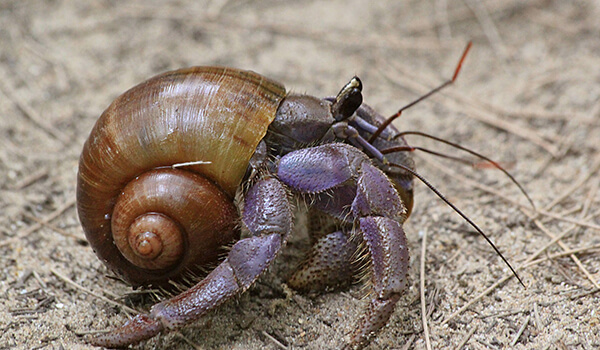
Photo: Hermit crab in nature
In order to fully get to know the hermit crab, you should know his diet. In this way, the hermit crab is very similar to its relatives – crustaceans, which means that it is also omnivorous and not picky. He does not disdain plant and animal food. His favorite delicacies are: algae, worms, fish caviar, molluscs, fish.
It happens that a hermit crab can eat carrion or food leftovers from nearby living anemones. If, for some reason, the crayfish has to go to land, then they feed on coconuts, fruits or small insects.
When moulting, the hermit crab sheds the shell and eats it, since it is an organic residue. This arthropod picks up any organic food. The habitat of the hermit crab greatly affects its diet. But in most cases, it's still algae, fish, worms, small crustaceans or echinoderms.
They mainly feed on the inflow and outflow of the coastal strip, or on any rocky surfaces. As for individuals living in aquariums, they can eat special food, well, or whatever is left on the dining table, cereals, chicken pieces, any groceries. In order to add some vitamin to his diet, you can feed him pieces of fruit.
Character and lifestyle features
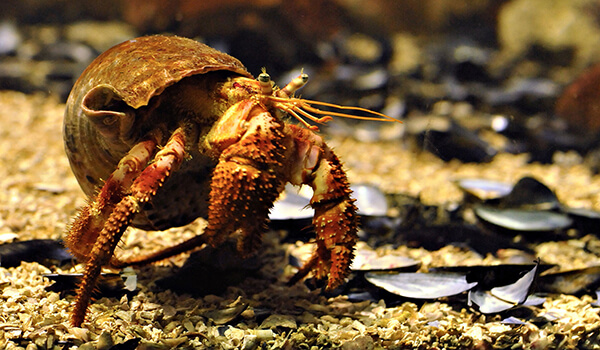
Photo: Hermit crab from the Black Sea
Hermit crab is distinguished by courage and endurance. Since a large number of enemies hunt him, he has to defend himself all his life. That is why, everywhere he drags the shell. Along with this, he is trying in every possible way to “establish” contacts with his fellows, even to negotiate. To establish their comfortable living, hermit crabs can exchange a shell.
At the moment when the arthropod changes its home, it becomes the most vulnerable. For additional shelter from predators, the hermit crab hides under rocks and in gorges. But this shelter becomes extremely unsafe for him at low tides.
For some lonely hermit crabs, a symbiosis with poisonous sea anemones is suitable. Such coexistence is mutually beneficial for both parties, since it helps to get food, and does not at all limit their independence. A striking example of such a symbiosis is the union of an arthropod and a sea anemone. Anemone settles on the shell of a hermit crab and uses it as a carrier.
Neighbors feed on the remains of each other's food. Together they can easily resist predators. I call such a mutually beneficial symbiosis mutualism, and they do not harm each other at all. The union breaks up only when the hermit crab is forced to change the shell due to an increase in size.
An adult hermit crab reaches a fairly large size and becomes strong. The arthropod lives exclusively in clean water. Hermit crab is active in search of food at any time of the day. It takes him relatively little time to “prepare” food and eat it.
Interesting fact: Hermit crab independently scouts and eats fish to the bone in just a couple of hours.
Social structure and reproduction
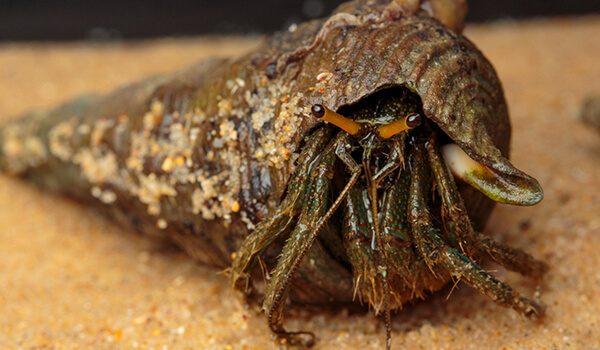
Photo: Marine Hermit Crab
Water-dwelling hermit crabs prefer to hang out with their brethren.
p>
Hermit crab co-habitation has the following advantages:
- The hermit crab does not need to spend energy searching for the right shell, because the brethren “acquiring” expanded living space, leave their shell;
- searching for food together with hermit crabs is much easier and simpler. As soon as one hermit crab finds food, he immediately informs the rest of his community;
- It is much safer to coexist in a group, since it is much easier to defend against enemies in this way.
If at least three hermit crabs gather in one place, their other relatives crawl to the same place. From a dozen arthropods, a “heap-small” is formed, in which everyone climbs on top of each other and in every possible way tries to throw each other off. In such a brawl, crayfish lose their shells. But at the same time, especially nimble individuals can acquire new improved housing.
Land hermit crabs do not like to cross paths with relatives precisely because of such gatherings. Left homeless on land, it is difficult for them to find a new shell. The breeding process of hermit crabs is based on the rivalry between males and females. Reproduction of arthropods occurs all year round. In the process of mating, eggs are produced, which they carry on their abdomen.
An interesting fact: a female hermit crab bears up to 15 thousand individuals.
A week later, larvae appear from the eggs, which are able to live independently in water. After four stages of molting, the larvae become small crustaceans that settle to the bottom. The primary task of young people is to find shelter in the form of a shell, no matter what becomes food for predators. In fact, only a few survive, even at the stage of maturation, many larvae die. On average, a hermit crab lives 10 years.
Natural enemies of hermit crabs
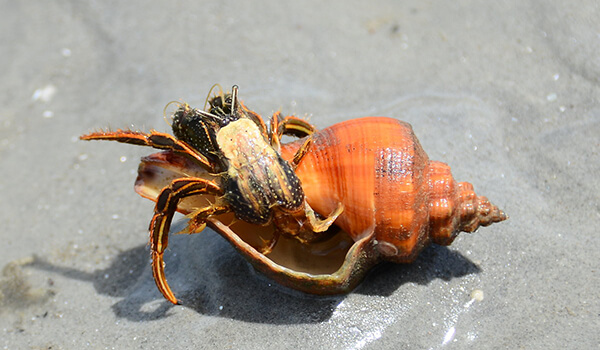
Photo: What a hermit crab looks like
The soft nourishing body of the hermit crab is of interest to many marine life. An unprotected hermit crab is a tasty morsel for predators. For most enemies, getting a hermit crab out of its shell is very problematic. Not only does the well-fed body of the arthropod completely fill the free space of the shell, but the hermit crab tightly holds the shell with its hind limbs. Anemone, which lives in symbiosis with hermit crab, creates additional protection for the hermit crab.
But every hermit crab has to deal with a change of residence. When he leaves his shell in search of a larger home, he becomes prey for marine inhabitants. Any marine animal that is larger than the hermit crab becomes its enemy. Its main enemies are cephalopods, octopuses, squids. Their powerful developed jaws easily quickly bite even a protective shell. Therefore, they carry a great danger to the hermit crab, even when he is in the house.
The larva of the hermit crab is endangered at every corner because, unlike the adult, it does not have a protective house. Hermit crabs fall prey to isopod and rhizopod parasites.
Population and species status
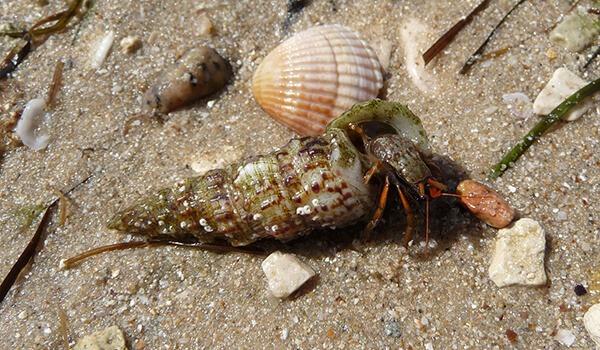
Photo: Hermit Crab
Hermit crabs are representatives of a large species. But every year its number began to decrease. A sharp decline in the population is associated with environmental pollution by mankind, in particular the seas. By studying hermit crabs and their characteristics, scientists are conducting research on the response of the seas to global warming and ocean acidification.
In addition to polluting the seas, parasites affect the population of hermit crabs. By infecting arthropods, they significantly regulate their numbers. About 9% of the arthropod population is infected each year. The degree of spread of infection depends on the season. The largest number of infected hermit crabs is observed in October (a quarter of the population), and the smallest – in March. Infestation with parasites decreases from March to October, it is in this period that the linear growth of hermit crabs slows down.
The density of the population of hermit crabs is greatly influenced by the temperature of the water, since the presence of parasites in it depends on it. Scientists have found that infestation with parasites affects the reproduction of hermit crabs. Thus, nature has created a mechanism that insures the population of arthropods from excessive reproduction.
The hermit crab is a natural orderly of the aquatic environment and feeds on all organic residues. That is why the places where arthropods live are clean. The population of hermit crabs serves as an indicator of the health of the ecosystem, since their number is inversely proportional to the level of environmental pollution.

